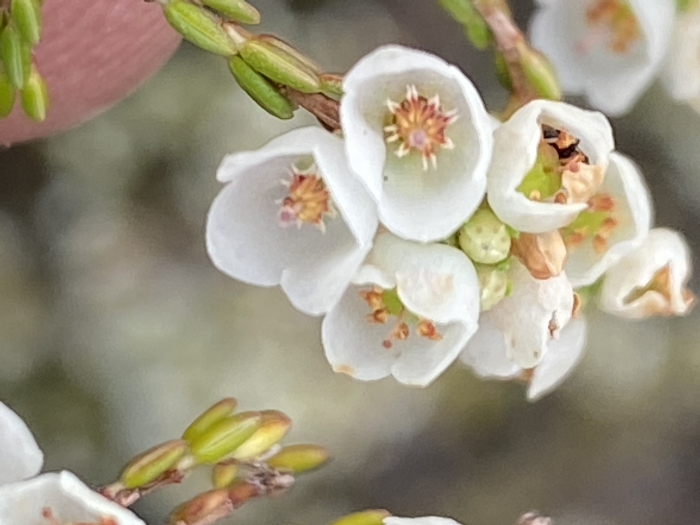Cape Heath
(Erica subdivaricata)
Cape Heath (Erica subdivaricata)
/
/

© Dave U
CC BY 4.0
Image By:
© Dave U
Recorded By:
Copyright:
CC BY 4.0
Copyright Notice:
Photo by: © Dave U | License Type: CC BY 4.0 | License URL: http://creativecommons.org/licenses/by/4.0/ | Uploader: knysna_wildflowers | Publisher: iNaturalist |

























Estimated Native Range
Summary
Erica subdivaricata, commonly known as Cape Heath, is an evergreen shrub native to the fynbos biome of South Africa, particularly within the Western Cape. This region is characterized by a Mediterranean climate with wet winters and dry summers, and the fynbos is a unique type of heathland known for its rich biodiversity. Cape Heath typically grows to a height and width of 2-3 feet (0.6-0.9 meters), presenting a compact, bushy habit. Its foliage is fine-textured, and the plant is adorned with numerous small, tubular pink flowers that are quite showy, blooming profusely in spring and summer.
Cape Heath is valued for its ornamental flowers and its ability to adapt to various garden settings. It is often used in rock gardens, as a border plant, or in containers. The plant’s moderate growth rate and evergreen nature make it a reliable choice for year-round interest. While it prefers full sun or part shade, it is also tolerant of coastal conditions and can thrive in sandy or loamy soils with good drainage. Regular watering is necessary, especially during dry periods, but overwatering should be avoided to prevent root rot. Cape Heath is generally disease-resistant but can be susceptible to fungal infections if conditions are too wet.CC BY-SA 4.0
Cape Heath is valued for its ornamental flowers and its ability to adapt to various garden settings. It is often used in rock gardens, as a border plant, or in containers. The plant’s moderate growth rate and evergreen nature make it a reliable choice for year-round interest. While it prefers full sun or part shade, it is also tolerant of coastal conditions and can thrive in sandy or loamy soils with good drainage. Regular watering is necessary, especially during dry periods, but overwatering should be avoided to prevent root rot. Cape Heath is generally disease-resistant but can be susceptible to fungal infections if conditions are too wet.CC BY-SA 4.0
Plant Description
- Plant Type: Shrub
- Height: 2-3 feet
- Width: 2-3 feet
- Growth Rate: Moderate
- Flower Color: Pink, White
- Flowering Season: Spring, Summer
- Leaf Retention: Evergreen
Growth Requirements
- Sun: Full Sun, Part Shade
- Water: Medium
- Drainage: Medium, Fast
Common Uses
Border Plant, Butterfly Garden, Low Maintenance, Potted Plant, Showy Flowers
Natural Habitat
Fynbos biome of South Africa, particularly within the Western Cape
Other Names
Common Names: Cape Heath
Scientific Names: , Erica subdivaricata, Erica assurgens, Erica caffra, Erica congesta, Erica eburnea, Erica exserens, Erica exserens, Erica pallidiflora, Erica pallidiflora
GBIF Accepted Name: